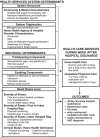Improving transitions and outcomes of sepsis survivors (I-TRANSFER): a type 1 hybrid protocol
- PMID: 35655168
- PMCID: PMC9160516
- DOI: 10.1186/s12904-022-00973-w
Improving transitions and outcomes of sepsis survivors (I-TRANSFER): a type 1 hybrid protocol
Abstract
Background: This protocol is based on home health care (HHC) best practice evidence showing the value of coupling timely post-acute care visits by registered nurses and early outpatient provider follow-up for sepsis survivors. We found that 30-day rehospitalization rates were 7 percentage points lower (a 41% relative reduction) when sepsis survivors received a HHC nursing visit within 2 days of hospital discharge, at least 1 more nursing visit the first week, and an outpatient provider follow-up visit within 7 days compared to those without timely follow-up. However, nationwide, only 28% of sepsis survivors who transitioned to HHC received this timely visit protocol. The opportunity exists for many more sepsis survivors to benefit from timely home care and outpatient services. This protocol aims to achieve this goal. METHODS: Guided by the Consolidated Framework for Implementation Research, this Type 1 hybrid pragmatic study will test the effectiveness of the Improving Transitions and Outcomes of Sepsis Survivors (I-TRANSFER) intervention compared to usual care on 30-day rehospitalization and emergency department use among sepsis survivors receiving HHC. The study design includes a baseline period with no intervention, a six-month start-up period followed by a one-year intervention period in partnership with five dyads of acute and HHC sites. In addition to the usual care/control periods from the dyad sites, additional survivors from national data will serve as control observations for comparison, weighted to produce covariate balance. The hypotheses will be tested using generalized mixed models with covariates guided by the Andersen Behavioral Model of Health Services. We will produce insights and generalizable knowledge regarding the context, processes, strategies, and determinants of I-TRANSFER implementation.
Discussion: As the largest HHC study of its kind and the first to transform this novel evidence through implementation science, this study has the potential to produce new knowledge about the impact of timely attention in HHC to alleviate symptoms and support sepsis survivor's recovery at home. If effective, the impact of this intervention could be widespread, improving the quality of life and health outcomes for a growing, vulnerable population of sepsis survivors. A national advisory group will assist with widespread results dissemination.
Keywords: Follow up physician visits; Home health care; Implementation science; Palliative care; Sepsis; Skilled nursing visits; Transitions in care; Type 1 hybrid.
© 2022. The Author(s).
Conflict of interest statement
The authors declare that they have no competing interests.
Figures
References
-
- Sepsis Alliance. 2019 Impact Report. [Internet] Sepsis Alliance; 2019. https://mailchi.mp/sepsis/2018-a-year-in-review-2669577?e=2897c0f998. Accessed 05 Aug 2021.
MeSH terms
Grants and funding
LinkOut - more resources
Full Text Sources
Medical
Research Materials


